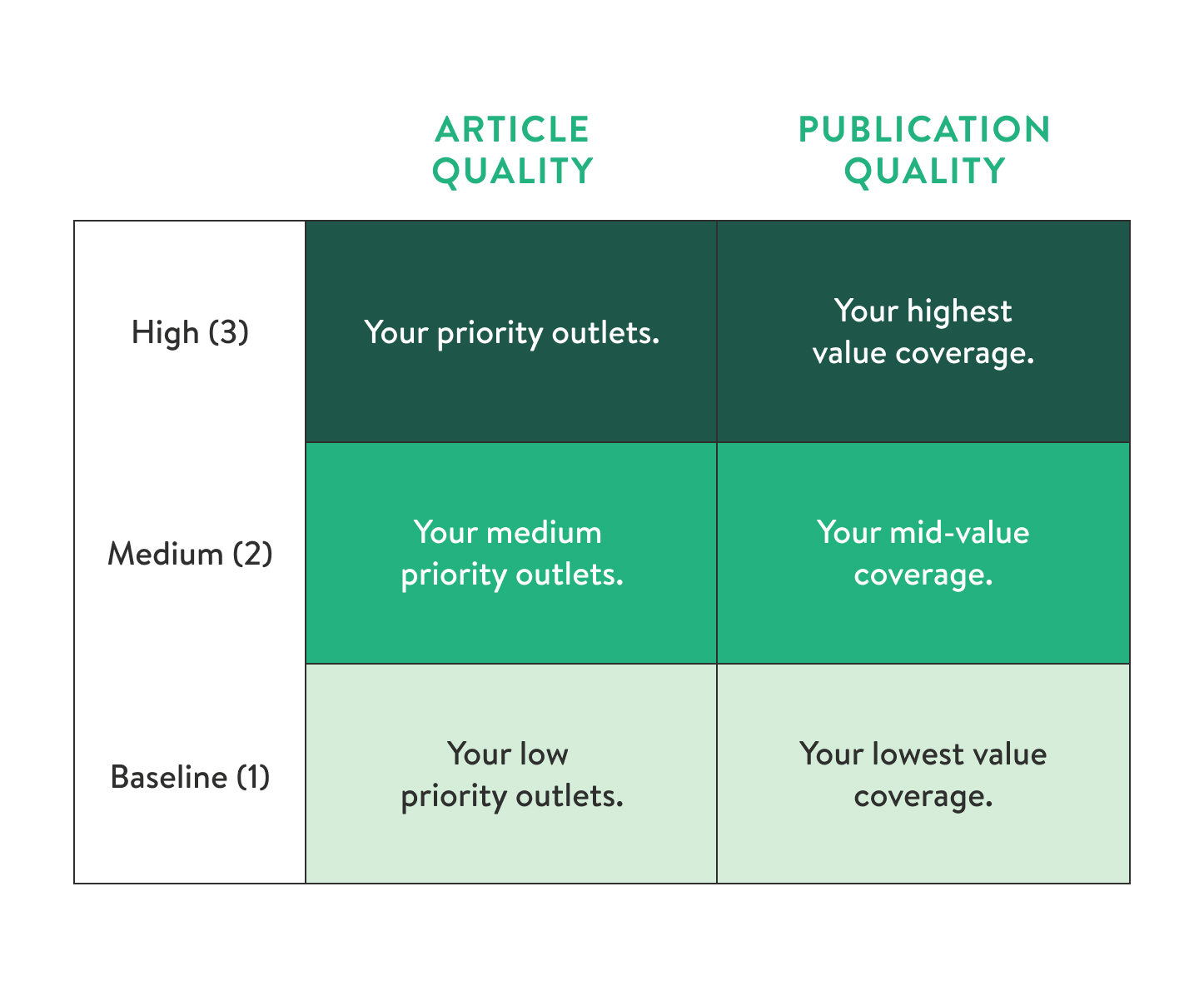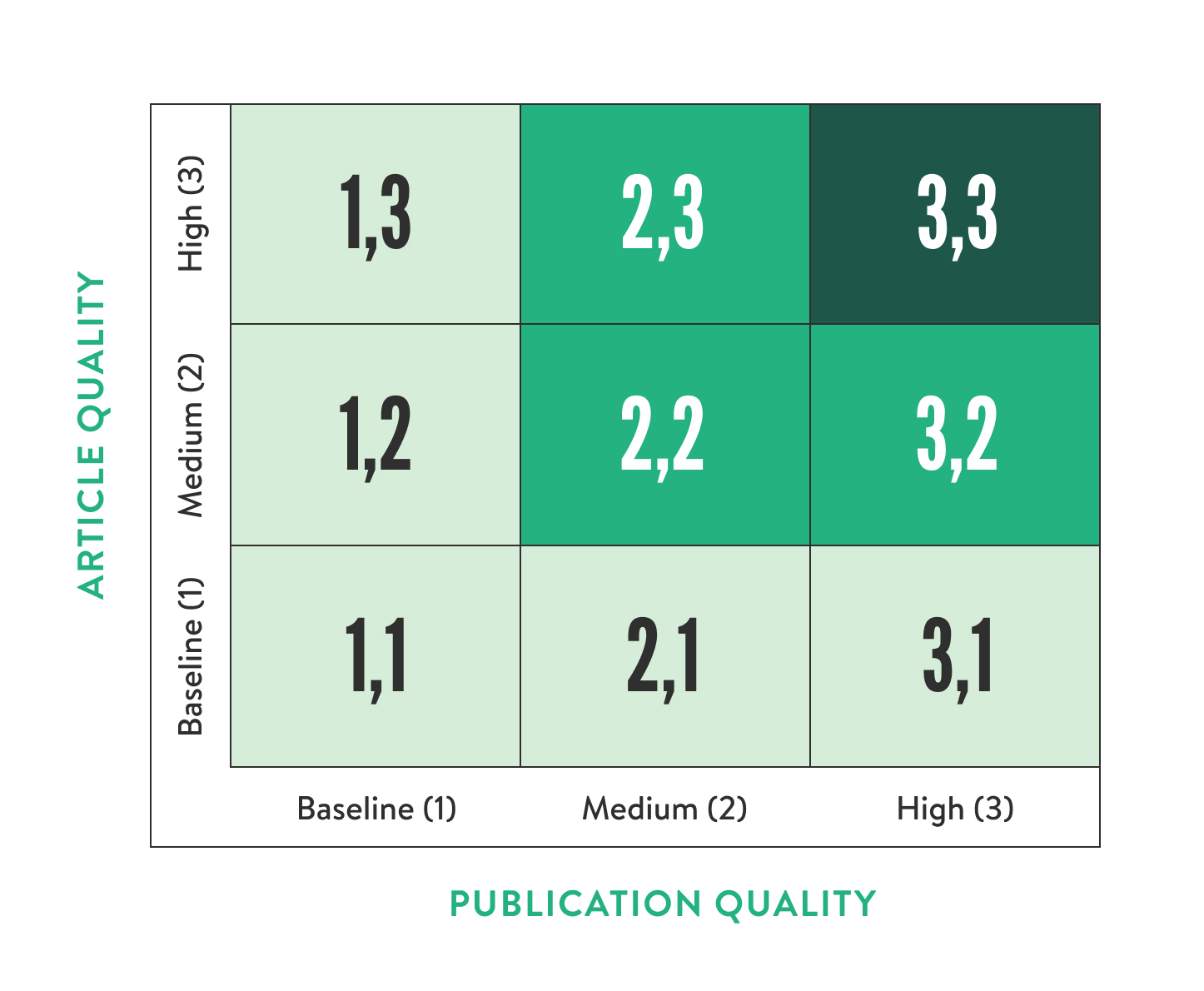While tactics like paid digital ads or lead generation programs offer metrics that clearly tie to sales, measuring earned media’s impact on business value is often more difficult. The reason for this complexity is also the key to solving it: to ensure accuracy and relevance, each company needs to customize its media measurement approach to align with its unique business objectives.
This guide will help you set precise media relations goals and select metrics that go beyond volume to assess the relevance of your coverage and its potential to impact the audiences you care about. You’ll learn how to define and quantify high-quality publications and articles tailored to your brand’s needs using a practical approach that aligns your media strategy with your overarching business ambitions.
Defining Media Coverage Value
To effectively measure the impact of media coverage, you first need to define what ‘value’ means for your organization. This definition should directly tie back to the strategic business objectives you aim to support through media relations. To fine-tune your measurement approach, take the following steps:
Step 1: Set Earned Media Objectives
Start by outlining what a successful media relations program looks like for your brand. Think about your short- and long-term expectations for how earned coverage will support your larger business goals.
Here are some program goals to consider:
- Reach specific audiences: Grow brand awareness within targeted market segments and reach potential customers.
- Strengthen relationships beyond stakeholders: Enhance ties and nurture long-term connections with current customers and partners.
- Develop thought leadership: Establish authority on industry topics and your offerings with an internal bench of subject matter experts.
- Protect brand reputation: Maintain and improve the perception of your brand.
- Drive sales: Boost leads and sales for new and existing products or services.
Step 2: Define Quality in Publications and Articles
After your program objectives are set, it’s time to define the types of publications and articles that will most effectively help you reach your goals. Honing in on these two aspects of media coverage will give you a holistic picture of what high-value media coverage looks like for you.

Publication quality: To pinpoint your priority outlets, think carefully about your audience. Who are they? Where are they getting their information from? What do they care about most? Focus on outlets that align closest to your audience and their needs, and consider both prestigious national publications and credible trade media. As you identify relevant media outlets, sort them into the following buckets:
- High quality: Outlets most likely to move the needle for your business goals.
- Medium quality: Outlets that provide some value but are not as strongly tied to business goals. These are often publications that can offer an impressive reach and general third-party credibility but lack a specifically tailored audience.
- Baseline quality: Outlets you’re likely to get picked up in, but don’t deliver much value. These “low-hanging fruit” targets are typically small outlets that can deliver quick or low-lift results, but probably won’t offer the caliber of coverage you ultimately want.
Article quality: To define high-quality coverage, consider what kind of content will best support your specific goals. For instance, if the article quotes your thought leaders, features your company, highlights a product, includes key messaging, contains a backlink, or mentions your partners. Group these criteria into the same buckets as your publications:
- High quality: Big wins. These articles directly correlate with your business goals and may feature your business, clearly convey a priority message, or quote a spokesperson throughout.
- Medium quality: Valuable, but not a slam dunk. These articles focus on the broader industry and may contain your thought leaders’ commentary.
- Baseline quality: Low-hanging fruit with minimal value. You likely aren’t directly pursuing these articles, or they may be syndications, photo captions, and citations.
Step 3: Quantify Quality
After setting objectives and defining what high-quality publications and articles look like for your company, the next step is quantifying these criteria. At INK, we use a media quality footprint matrix to visually compare the quality of each article against the quality of the outlet in which it appears.

To set up this matrix:
- Create axes with baseline, medium, and high quality for both publications (X-axis) and articles (Y-axis).
- After you secure coverage, assess its publication and article quality based on your definitions and assign a corresponding coordinate within the matrix. For example, if coverage has a medium publication quality and high article quality, it would be located in the 2,3 cell.
- With each new piece of coverage, assign its coordinate and then add up the total number or articles within each cell.
- While earned coverage can never be fully under your control, aim to maintain a set percentage within the medium to high-quality range — represented by shaded green squares— which shows progress towards your business and program objectives.
By using this tool, you can transform subjective observations into objective data. This allows you to effectively communicate the credibility, authority, and influence of your coverage and provide a comprehensive view of the value of your media efforts.
Use Media Coverage Measurement to Adjust Strategy
The ability to quantify and measure the quality of your media coverage not only gives you a straightforward way to communicate its value, but it also can serve as a strategic tool. For instance, we use the media quality footprint to identify gaps in coverage, adjust pitches, and shift our approach to enhance outcomes.
If your strategy isn’t driving results that matter (i.e., the shaded top right of the matrix), there are likely two areas for adjustment:
- High article quality, low publication quality (top left of the matrix): If you find yourself with high article quality but low publication quality, it indicates that your story is resonating but perhaps not with the right outlets for your company. In this case, you’ll want to strengthen relationships with priority publications by regularly sharing news and offering unique insights to support their reporting.
- Low article quality, high publication quality (bottom right of the matrix): High publication quality but low article quality suggests that outlets recognize your company and its relevance, but your angles may need to be more interesting to warrant a feature story. You’ll want to enhance your narrative with hard news, original data, or compelling spokespeople. Consider what assets reporters from these publications typically need to publish an article and then refine what you’re sending them through that lens.
Boosting Business Impact Through Media Measurement
Moving beyond traditional coverage metrics to include measurements like publication and article quality can help you overcome lackluster program reporting, inform ways to improve your approach, and increase the value your company places on earned media. At INK, we’re passionate about leveraging data-driven strategies to guide our clients from setting objectives and strategies to measuring outcomes. If you need a hand, we’re here to help.



